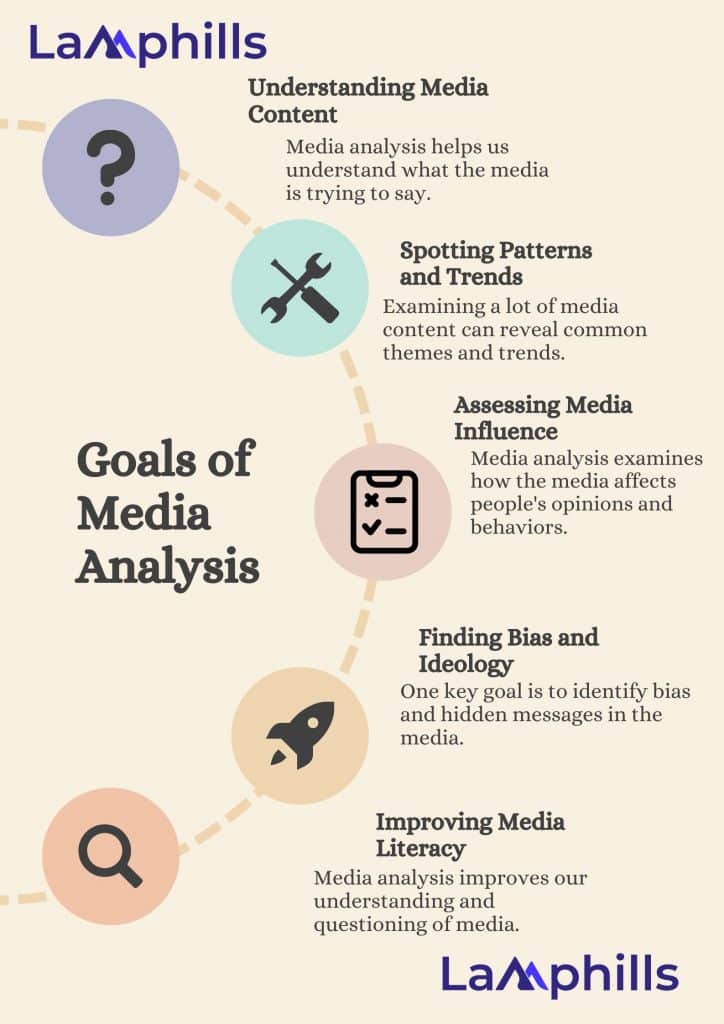Sometimes, I wonder why some advertisements or news stories stick with us while others fade away. It all comes down to my understanding of the intricate world of media analysis. You might be asking, “What is media analysis, and why is it so important?” Let’s uncover the secrets behind the screens, the definitions, techniques, and types, and how to write media analysis. Let’s get started!
Key Points
- Media analysis is vital for businesses and organizations as it provides strategic insights into media coverage, helps understand the media landscape, evaluates media relationships, and assesses the impact of key messages on audiences.
- There are two main types of media analysis: quantitative and qualitative. Quantitative analysis focuses on numerical data, like the frequency of mentions, while qualitative studies examine the context and connection between messages and their intended audiences.
- Media analysis involves collecting stories from various media outlets, categorizing them, and analyzing the content. This includes identifying buzzwords, biases, and the portrayal of stories.
- Writing a media analysis essay includes an executive summary, methodology description, evaluation of media coverage, spokesperson analysis, and framing analysis. It concludes with recommendations based on the study to guide the introduction and framing of new stories in the media.
What is Media Analysis?
Media analysis plays a critical role in developing a solid marketing strategy. To fully comprehend its importance. Let’s define it and discuss its significance to business success.
Media analysis has a long history, and Harold Lasswell introduced the term “media content analysis” in 1927. Initially, it was a methodical approach to studying mass media, primarily the press, television, and radio. Over time, media monitoring has become a complex strategy that includes an extensive analysis of digital content, such as websites, social media, and visual content.
Marketers have been conducting media analysis for years. However, in the past, they had to manually search for brand mentions, which took up a significant amount of their time. In today’s world, where information overload and millions of websites exist, it would be impossible to manually search and analyze the media each company mentions. That’s why automation of media analysis has become an essential part of the process.
Social media analysis involves collecting and analyzing information from social networks to help make better business choices. It also allows organizations to check their performance based on those decisions by looking at social media outcomes. This process will help you understand what people say and feel about your brand or products. You can use this insight to improve your strategies and engage your audience more effectively.
Understanding the Techniques of Media Analysis
Let me share some personal insights on the definitions and techniques of media analysis. Media analysis involves studying how media content affects our perceptions and behaviors. It includes looking at everything from news articles to social media posts, focusing on the words, images, and symbols used.
One essential technique is quantitative analysis, where we measure the number of times a brand is mentioned or how often a specific topic appears. This helps us see trends and patterns. For example, by counting how many times a product is mentioned in different media outlets, we can understand its popularity and reach.
Another essential technique is qualitative analysis, where we interpret the deeper meaning behind the media content. This involves examining the context and the subtle messages that might not be immediately obvious. For instance, analyzing a commercial’s underlying messages about gender roles or societal values can reveal much about its impact and intentions.
Combining these techniques provides a well-rounded understanding of media content. For instance, I once analyzed a famous commercial that seemed straightforward but had hidden messages about gender roles and consumer culture. This deeper understanding changed how I viewed that commercial and all media content.
Media analysis is a powerful tool that helps us see beyond the surface and understand the actual influence of media. It’s like having a magnifying glass that reveals the hidden layers of meaning in everything we watch, read, and hear.
Why Is Media Analysis Important?

Credit: rawpixel
Media analysis is incredibly valuable for businesses and other types of organizations. It plays a crucial role in offering strategic insights not only into your own media coverage but also into that of your competitors. Doing so helps you better understand the landscape you’re operating in. Additionally, it evaluates the effectiveness of your relationships with the media. This is key to ensuring that your communications strategy works as intended and that your intended audience receives and understands your messages.
Furthermore, media analysis can assess how to impact your key messages. This means it checks whether the messages you’re sending out resonate with your audience and achieve the desired effect. Overall, media analysis provides a comprehensive view of your position in the media landscape, enabling you to make informed decisions and strategic adjustments to your communication plans.
If you’re curious about the media’s influence and want to understand it better, stick with me.
Types of Media Analysis
Understanding the types used for analyzing media is crucial. It’s not something to be done randomly. First, examine how news about your products or services has been covered. What’s being said about your industry? This information is important for your analysis.
The key methods are:
- Quantitative analysis
- Qualitative analysis
Each has its advantages and disadvantages. Quantitative analysis is all about numbers. It involves tracking how often something of interest is mentioned. This method includes looking at:
- The number of times something is mentioned
- How widespread the coverage is
- How the media is divided
- The proportion of the conversation your topic holds
Qualitative analysis, however, focuses on the connection between the message and its intended audience. It tries to understand the context of the message. This approach interprets what the media, across different platforms, is trying to communicate to the public. A thorough media analysis should use both methods to be reliable.
Media analysis is detailed and vital for any business looking to stand out. While market research has been the focus for many years, the value of media analytics is becoming more recognized. So, it’s important not to fall behind your competitors in this area.
How To Write a Media Analysis
Let me share with you the 3 parts of how you can write a media analysis:
#1. Collecting Stories to Analyze

Credit:rawpixel
List all of the media outlets in your area. Include newspapers, news websites, radio stations, television news shows, and any other media outlets you want to include. Depending on the story you hope to share and its scope, you may extend your search to include statewide and national media outlets.
- For example, include the local newspaper, radio station, web news sources, and any primary news sources in the nearest big city if you’re in a rural area or suburb.
- Alternatively, you could focus on national or worldwide news sources to analyze a larger company or subject.
Make a list of search terms based on your topic. Identify the key terms that will help you gather articles about pic. This will help streamline your research by giving you terms to plug into each media channel you investigate.
- For example, suppose you’re conducting a media analysis of the controversy over a major highway construction project in your city. In that case, you might include terms like “highway construction,” “highway controversy,” “construction budget concerns,” etc.
Collect News Stories from Research Databases from the Last six Months
Use the key terms to find articles on your topic in databases, such as subscription resources like Lexis Nexis and Ebsco Host or free resources like Google Scholar. Plan to go back about six months and collect between 100-200 articles if you’re doing a professional media analysis.
- Include various media sources unless you want to examine a specific medium, such as T.V., radio, or print news.
- Tip: If desired, you may expand your search to cover a more extended period, such as 12 months. This may result in a more thorough study of the topic.
Separate the stories into categories and eliminate irrelevant data. You’ll likely collect three main categories: opinion, news, and feature stories. Eliminate obituaries, calendar items, and any other extraneous items from the data you collect.
- Separating the data into categories can help you know what to expect when reading a story.
Checkout our articles on Social Media Release: How to Write With My Templates (+Tips)
Press Kit vs Media Kit: Which One Does Your Business Really Need?
#2. Analyzing the Stories
Read the articles and underline or take notes. This will make it easier for you to write about your findings. Use a pen or highlighter to note important information in print articles, or note this information if you’re reading digital media or examining T.V. or radio sources. Some things to watch for as you review the media you’ve collected include:
- Buzzwords are terms that come up again and again across different media channels.
- Bias uses emotional appeals to convince readers of something, even if the evidence is lacking.
- Similar portrayals of a story, such as portraying it positively or negatively across different media channels.
- Positioning of the story, such as whether it’s a front-page or prime-time news story.
Tip: The length of the story helps you determine its importance. For example, if a short story appears on one page, the news outlet may deem it less necessary than something that takes up multiple pages.
Answer Questions About the Articles you read
A significant part of the analysis is asking questions and answering them based on the evidence you find in your sources. Some questions you might consider as you review the sources you’ve gathered include:
- How does the media frame this topic?
- Who are the spokespeople for the topic, and how are they represented?
- Are any voices noticeably absent from the articles on this subject?
- What topics are getting the most coverage within the category?
- What media outlets are covering this topic?
- Does coverage seem to peak or drop at certain times of the year?
Summarize what you have learned. After completing your media analysis, summarize what you have learned about how the media covers your subject. Include your answers to all your questions about the data you collected. Note anything of particular importance or that you’re still unsure about.
- For example, if you have noted that most news outlets portray your subject using a set of buzzwords and a similar level of bias, then you may describe and discuss these.
Identify ways this may help you introduce your own story. A media analysis is a helpful way to determine how best to introduce a story into the media. Consider what you’ve learned and decide if any strategies may help to get your story out to a broader audience or make it more appealing to readers.
- For example, if the sources you consulted all portray a public concern in a similar light, you may not adopt this method of framing your topic.
#3. Structuring a Media Analysis Essay
Compose the executive summary to introduce your analysis. The executive summary is where you introduce your topic, state your purpose, and give an overview of your findings. It’s essentially a preview of your media analysis. Provide any background information about your topic that readers may need to know, then identify why you chose to investigate this topic and briefly explain what you discovered from your research.
- For example, you might begin by saying that your topic is an upcoming election in your community and that you wanted to do a media analysis to determine how to introduce your story. Then, you might conclude by saying what media channels discuss this topic in common.
Describe your Methodology
This is the section where you describe your research process, such as the search terms you used, your sample size, the media outlets you sourced articles from, the time frame, and the databases you consulted. Be as detailed as possible when you describe your methodology.
Tip: In this section, clarify any special terms or details your readers might not understand.
Evaluate the topic to determine how the issue is being covered. Consider what your findings have revealed about how media outlets cover your topic. This is an excellent place to respond to some of the questions you’ve asked and answered about your topic, such as:
- What aspects of the topic are being covered?
- What buzzwords do the media channels use?
- Do the media channels tend to show bias on the subject, and if so, how?
Provide the spokesperson analysis. Spokespeople include business leaders, professionals, advocates, public and government officials, members of the general public, and academics. Tally up the frequency with which each type of spokesperson appears in the articles you review and mention these numbers in this section of the media analysis. You may even consider making a chart to show which spokespeople are being quoted most and least often.
- This can help you determine what spokespeople to include in your article.
Transition to the framing analysis to identify archetypes
Reporters may rely on one or more archetypes to frame a story, which can help you determine what might work best for your story. Identify any archetypes used in your reviewed stories and see what ones come up most and least often.
- For example, you might notice that the “hero takes a fall” archetype is frequently used for the articles in your topic area. Choosing this frame for your story could be beneficial.
Give readers your conclusions and recommendations. At the end of the media analysis, explain the study’s significant findings and how this may benefit your reader or organization. This may include detailed suggestions for how to frame a story, where to place it in a media channel, and who to quote in the story. Be as detailed as possible, and cite specific examples from your study to support your recommendations.
- For example, if you recommend including a business professional, professor, and community member in the coverage of a story, cite the data you have collected that shows these spokespeople as the picks for stories on your topic.

What Is the Goal of Media Analysis?
Media analysis is all about understanding and evaluating what we see, hear, and read in the media. Let’s break down the main goals of media analysis in simple terms:
- Understanding Media Content: Media analysis helps us understand what the media is trying to say. We can understand the messages and their meanings by examining the words, pictures, and symbols used.
- Spotting Patterns and Trends: Examining a lot of media content can reveal common themes and trends. This helps us understand what topics are often discussed and what stories are popular in the media.
- Assessing Media Influence: Media analysis examines how the media affects people’s opinions and behaviors. It helps us understand how what we see in the media can shape our thoughts and actions.
- Finding Bias and Ideology: One key goal is to identify bias and hidden messages in the media. This means examining how different groups or issues are presented and determining whether an agenda or certain viewpoints are being pushed.
- Improving Media Literacy: Media analysis improves our understanding and questioning of media. By learning how media messages are made and their effects, we become smarter and more critical media consumers.
- Guiding Media Production: Media analysis insights can help media creators create better content and show where more balanced or diverse representation is needed.
- Supporting Research: Media analysis is helpful in research. It provides a method to study media in a structured way, helping researchers learn more about communication and society.
Don’t let your brand’s story go unheard. Partner with LampHills and unlock the power of strategic media relations.Get Started Now
Related Post
Everything You Should Know About Media Analysis (+ Template)
Top 33 Social Media Analysis Tools In 2024
Top Paid Media Tips to Explode Your Business Growth






